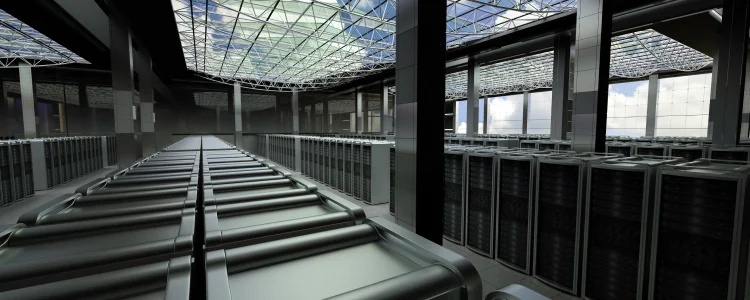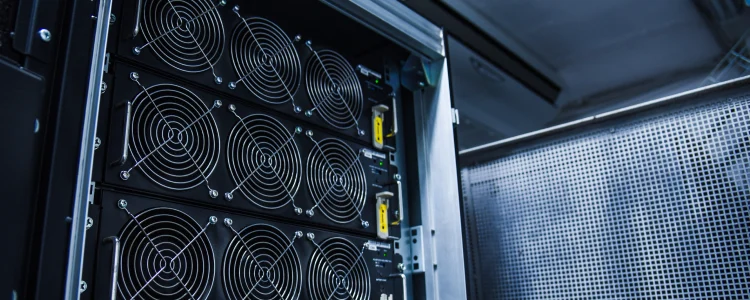How are Data Centers Cooled? Systems, Technologies and Solutions

Data center cooling solutions are vital to keeping facilities, businesses, and governments operating. It’s no secret that data centers are important, but keeping them running is a massive challenge and cooling efficiency is what does it. Without properly cooled and managed data centers, the servers inside can easily overheat or stop working, stopping everything in it’s tracks.
With seven different colocation data centers across the globe under our belt, we at ServerMania know exactly how important cooling systems can be. From coast to coast, London, or Europe, we have been connecting businesses with customers for over 20 years.
In this article, we’ll show you just how important data center cooling actually is, the different types of data center cooling, and some of the factors that make up effective data center cooling.
Why is Data Center Cooling So Important?
Data centers are an essential part of modern businesses. While they’re vital for storing, processing, and sending important data all across the globe, they also generate a significant amount of heat (thanks to the high-density computing power needed to manage these loads).
Each server can emit anywhere from 400 to 700 watts of heat per hour, and in larger data centers, this can add up to an incredible amount of heat generated. If a cooling system fails to perform, this can lead to increased inefficiencies, possible hardware failures, and system downtime; all of which can severely impact a business.
Why Effective Data Center Cooling Matters
Cooling efficiency is more than just keeping hardware operational, it’s also a big factor in energy consumption. On average, about 40% of a data center’s total energy usage is purely for cooling alone. And considering that about 2% of the US’ energy consumption is taken by data centers, the impact can be massive. That can result in millions of dollars annually between different data center tiers. Without optimized cooling solutions, businesses could see a drastic rise in operational expenses, especially if energy prices are raised.
Additionally, the increasing pressure to meet environmental standards makes efficient cooling even more essential. Poor cooling performance impacts energy usage and also contributes to a larger carbon footprint, making it harder for data centers to comply with sustainability goals and government regulations.

The Different Data Center Cooling Technologies
With modern data centers being such a crucial part of most business operations in today’s world, ensuring they’re using optimal cooling systems is a critical priority. There are multiple different data center cooling solutions, each that meet different operational needs, climates, and scales. Let’s break down some of the most commonly used data center cooling solutions, how they work, and the pros and cons for each.
Air Cooling
Air cooling is the most traditional and widespread method used for data centers. it uses air cooling units to circulate cool air through server racks, usually with the help of fans and air conditioning systems. It’s a simple and cost-effective option for smaller data centers, or those with low to medium server density.
How it works: Air is cooled via traditional HVAC systems (Heating, Ventilation, and Air Conditioning) and distributed throughout the data center. Fans (or blowers) direct the cold air through the servers, absorbing the heat generated, which is then expelled, either back into the facility or out into the atmosphere.
Pros:
- Cost-effective: Initial setup and maintenance costs are relatively low. Compared to other methods, air cooling doesn’t require complex infrastructure or expensive materials.
- Easy to Implement: Standardized equipment and widespread availability make it easy to deploy. Your existing HVAC systems can often be used with minimal upgrades, and it can be managed by data center operators.
- Scalable: Can be adjusted for small to large data centers. Adding more fans or computer room air conditioners can help meet increasing demands.
Cons:
- Inefficiency at Higher Densities: It can be substantially less effective for higher-density data centers. Overcrowded racks can impede airflow, creating hotspots.
- Higher Energy Consumption: Fans and air conditioning can consume a significant amount of power, which raises operational costs and environmental impact.
- Temperature Regulation Issues: Ensuring consistent temperature throughout a data center can be challenging, Cold air and hotspots can occur if air flow isn’t perfectly managed.
Liquid Cooling System
Liquid cooling is an advanced method that’s becoming more prevalent, especially as data centers start hosting more high-performance computing systems. This method uses a liquid, such as water or a special coolant, to absorb heat directly from the servers, offering significantly higher efficiency than air cooling.
How it works: Liquid is circulated through cold plates or heat exchangers that are attached directly to the server components that generate the most heat. This liquid cooling absorbs the heat and then moves it away from the servers, cooling the hardware more efficiently than air cooling.
Pros:
- Higher Efficiency: Better heat absorption capabilities mean liquid can remove heat more effectively than air.
- Space-saving: Smaller cooling units, freeing up valuable data center space. Liquid cooling systems can be designed to fit very tightly around components, maximizing server density.
- Silent Operation: Reduced noise compared to air cooling systems since there are fewer and smaller fans involved.
Cons:
- Higher Initial Costs: Installation and setup are more expensive due to the need for specialized equipment and materials.
- Complex Maintenance: Requires specialized knowledge and equipment for repairs and regular maintenance.
- Potential Leak Risks: There’s a risk of coolant leaks, which could damage hardware. Even with safety measures in place, any leak could lead to costly downtime and repairs.
Chilled Water Systems
Chilled water cooling is commonly used for large scale data center cooling systems. This technology uses chillers to cool water, which is then circulated through heat exchangers to absorb and remove heat from the data center. Unlike traditional liquid cooling, the addition of colder water leads to a more efficient method, and isn’t pumped directly to components.
How it works: Chillers reduce the temperature of water, which is then pumped through a network of pipes to cooling coils or other heat exchanger devices. As warm air from the data center passes over the coils, heat is transferred to the water, which then flows back into the chiller to be cooled again.
Pros:
- Highly Effective: Excellent for high-density data center environments where air cooling falls short.
- Energy Efficiency: It can be more energy-efficient than traditional air cooling, particularly when used in conjunction with free cooling methods that exploit cooler outdoor temperatures.
- Temperature Stability: This method provides consistent and reliable temperature control, essential for maintaining optimal performance and longevity of server hardware.
Cons:
- High Initial Investment: There can be significant installation costs for piping, chillers, and heat exchangers.
- Complex Infrastructure: It generally requires substantial changes to existing data center setups, which may not always be feasible.
- Maintenance Requirements: Regular upkeep and monitoring is needed to prevent malfunctions, along with a need for water quality management to avoid corrosion and scaling.
Evaporative Cooling
Offering a more environmentally friendly cooling method than others, evaporative cooling uses the natural process of evaporation to cool the air before it’s circulated through the data center. This becomes even more effective in areas with low humidity and dry climates.
How it works: Hot air from the data center passes over water-saturated pads (or surfaces), causing the water to evaporate and, in the process, cooling the air. This cooler air is then used to lower the temperature of the server environment.
Pros:
- Energy-efficient: It offers lower energy consumption compared to traditional cooling methods since it relies on the natural cooling properties of water evaporation.
- Environmentally Friendly: It uses water as a cooling medium, reducing the reliance on refrigerant gases that can be harmful to the environment.
- Cost-effective: There are lower operational costs over the long term due to reduced energy usage.
Cons:
- Climate Dependent: It’s less effective in humid environments where the air already has a high moisture content, limiting evaporation’s cooling potential.
- Water Usage: It consumes a significant amount of water, which may be a concern in water-scarce areas or during drought conditions.
- Complex Controls: It requires precise control systems to manage evaporation rates and ensure consistent cooling performance.
Hot and Cold Air Aisles
Hot and cold aisle containment is an airflow management technique that’s used to optimize the cooling process by separating hot and cold air within the data center. This helps ensure that cold air is directed to the server’s intake side while hot air is exhausted efficiently. ServerMania’s Montreal Data Center utilizes this design to provide high-density cooling to servers inside.
How it works: Server racks are placed in alternating rows, with cold air intakes facing one aisle (the cold aisles) and hot air exhausts facing the other direction (making hot aisles). Containment systems or barriers are often used to prevent the mixing of hot and cold air, maximizing cooling efficiency.
Pros:
- Improved Efficiency: It optimizes airflow, reducing cooling requirements and energy consumption.
- Better Temperature Management: By preventing hot air from mixing with cold air, it maintains a consistent temperature across the data center.
- Cost-effective Solution: Enhances existing air cooling systems without significant upgrades, making it a practical choice for many data centers.
Cons:
- Space Constraints: It requires specific data center layout and space planning, which may not be possible in all existing setups.
- Initial Setup: There may need to be some reconfiguration of existing server racks to align with hot and cold aisle principles.
- Careful Management: It needs diligent management to ensure optimal airflow boundaries, requiring continuous monitoring and adjustments to maintain effectiveness.

Designing a Cooling System for Maximum Efficiency
Creating an efficient data center cooling system is important, but how do you do it effectively? Let’s check out three important factors that should be considered.
Capacity Planning
Proper capacity planning ensures that your data center cooling systems are capable of handling the heat load generated by the servers. As server density increases, the cooling system must scale to prevent overheating without wasting energy. Ideally, plans for future growth should also be considered to prevent overloading the system, which could result in equipment failures or inefficiencies.
Redundancy and Reliability
To maintain uptime, cooling systems need redundancy. In the event of a failure, backup systems like additional chillers or redundant air paths ensure uninterrupted cooling. This protects hardware and data while still minimizing the risk of costly downtime caused by cooling issues.
Energy Efficiency Considerations
Energy efficient cooling helps reduce operational costs, but it also helps meet environmental goals. Optimizing goals, using variable speed fans, and adopting free cooling systems and renewable energy sources (like our New York Colocation Center) can drastically reduce energy consumption. This cuts costs but also supports sustainability efforts and helps reduce carbon footprints, both important for keeping our earth healthy.
Airflow Management
Effective airflow management is critical for maintaining efficiency, regardless of what data center cooling technologies you use. Techniques like hot and cold aisle containment, proper rack placement, and preventing air recirculation ensure that cold air reaches the servers efficiently, while hot air is pushed out. By reducing air mixing (and checking for hot and cold spots), you can improve cooling performance and reduce the energy needed to maintain temperatures.
Keep a Cool Head (And a Cooler Server)
Intricately designed cooling systems aren’t just for tech YouTubers and massive corporations. Whether you’re designing your own data center, or your business is expanding beyond a few dedicated servers, keeping them running at maximum efficiency is key.
And with an average data center size being about 100,000 square meters, keeping them cool isn’t as simple as flipping on the air conditioning. With different data center cooling options available, finding the right balance between cost, energy efficiency, and effectiveness can be tough.
So why do the hard work yourself? Contact us today and see how we can get your business servers up and running in one of our state of the art data centers. Whether you’re working small-scale or enterprise, ServerMania can get you online and production-ready.
Was this page helpful?

